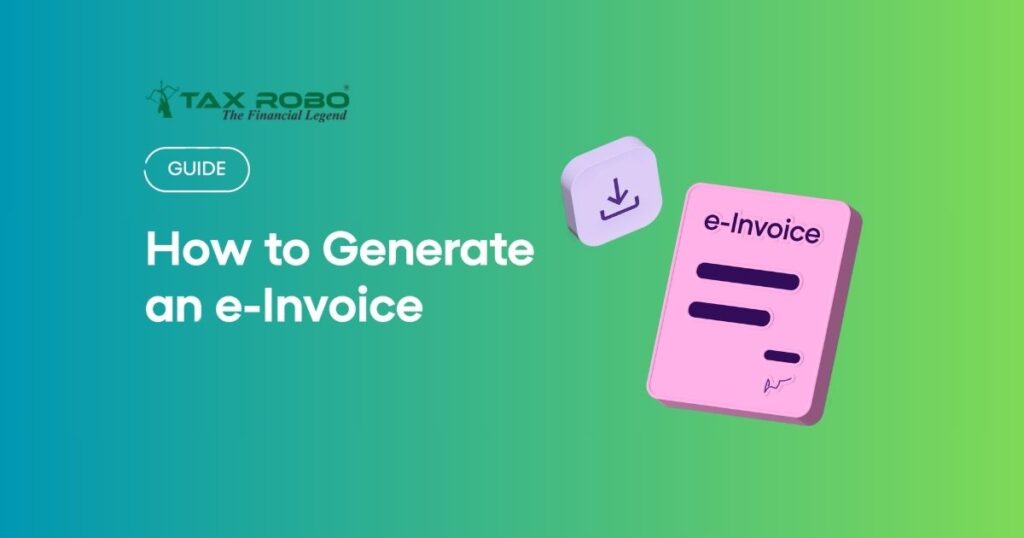Step-by-Step Process to Generate an e-Invoice and IRN in India
Introduction: Simplifying Compliance with E-Invoicing
India’s Goods and Services Tax (GST) system is constantly evolving, embracing digitalization to improve efficiency and transparency. A significant step in this journey is the introduction of e-invoicing. For many businesses, understanding how to generate e-invoice documents has become essential. E-invoicing is crucial not just for meeting GST compliance requirements, but also for promoting transparency in business transactions and significantly reducing opportunities for tax evasion. It standardizes invoice reporting, making processes smoother for both businesses and the tax authorities.
So, what exactly is an e-invoice in the Indian GST context? It’s not simply a digitally generated PDF. An e-invoice is a standard invoice generated by your accounting or billing software, whose data is then electronically reported to and validated by the official Invoice Registration Portal (IRP). Upon successful validation, the IRP issues a unique Invoice Reference Number (IRN), digitally signs the invoice data, and adds a QR code. This entire package constitutes the valid e-invoice. The IRN is a 64-character unique identifier that marks the invoice as officially registered with the government. This post serves as a comprehensive step-by-step e-invoicing guide India, designed specifically for small business owners and GST-registered individuals who need to navigate the e-invoice generation steps for businesses and understand why this process is vital for their compliance and operational efficiency.
Who Needs to Generate E-Invoices in India?
Understanding E-Invoicing Applicability
Not every business registered under GST needs to generate e-invoices immediately. The requirement hinges primarily on your Aggregate Annual Turnover (AATO) in a preceding financial year. The government introduced e-invoicing mandates in phases, starting with businesses having higher turnovers and gradually lowering the threshold. To ensure your business complies with GST regulations, learn more about GST for e-commerce businesses: Key Considerations.
It’s crucial to know the current AATO threshold that triggers mandatory e-invoicing. This limit has been revised downwards over time. We strongly advise checking the official GST portal (GST Portal) or the Central Board of Indirect Taxes and Customs (CBIC) website for the latest, most accurate turnover limit, as this figure is subject to change based on government notifications. Businesses exceeding the specified AATO must generate e-invoices for specific transactions, primarily:
- Business-to-Business (B2B) Supplies: Invoices issued to other GST-registered businesses.
- Exports: Invoices related to the export of goods or services.
- Supplies to Special Economic Zones (SEZs): Invoices for supplies made to SEZ units (with or without payment of tax).
However, certain entities and transactions are generally exempt from the e-invoicing mandate, even if their turnover exceeds the threshold. Common exemptions include:
- Insurance companies, Banking companies, Financial Institutions (including NBFCs)
- Goods Transport Agencies (GTAs) supplying services related to transport of goods by road in a goods carriage
- Suppliers of passenger transportation services
- Suppliers of services by way of admission to exhibition of cinematograph films in multiplex screens
- Government Departments and Local Authorities
- SEZ Units (as recipients of services are usually covered, but SEZ units themselves were initially exempt for their outward supplies – always verify current rules)
Again, always refer to the latest official notifications on the GST Portal for the definitive list of exemptions and current applicability criteria, as these rules can be updated. Understanding these e-invoice generation steps for businesses begins with correctly identifying if the mandate applies to you.
Prerequisites: Getting Ready to Generate an E-Invoice
Essential Requirements Checklist
Before you can start the process to generate e-invoice documents, you need to ensure certain prerequisites are met. Being prepared will make the transition smoother and help avoid compliance issues down the line. Think of it as gathering your tools and ingredients before starting to cook.
Here’s a checklist of essential requirements:
- GST Registration: This is fundamental. Your business must be registered under the Goods and Services Tax (GST) Act. E-invoicing is a component of the GST framework. Learn the essentials with our Ultimate Guide to GST Registration for Small Businesses.
- IRP Registration: You must register your GSTIN on the government’s designated Invoice Registration Portal (IRP). The primary portal is https://einvoice1.gst.gov.in, though others may be added. Registration is typically done using your existing GSTIN credentials through an OTP verification process on the portal. This step authenticates your business for reporting invoices.
- System Readiness: You need a mechanism to create the invoice data in the prescribed format (JSON) and transmit it to the IRP.
…
By being proactive and adopting these practices, businesses can navigate the e-invoicing landscape effectively.
Conclusion: Mastering the E-Invoice Generation Process
…
Need help navigating the complexities of e-invoicing implementation, GST compliance, or choosing the right accounting solutions? TaxRobo offers expert assistance and tailored services for Indian businesses. Our team can guide you through the e-invoice generation steps for businesses and ensure you stay compliant. Discover more from our Taxation Services in India. Contact TaxRobo today for expert GST Service!



